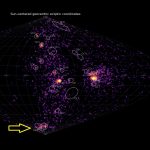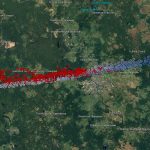Roberto Gorelli points our attention at a recently published meteor related paper:
Modeling the past and future activity of the Halleyids meteor showers
This article has been submitted for publication in Astronomy & Astrophysics by A. Egal, P. Wiegert, P. G. Brown, M. Campbell-Brown, and D. Vida.
Abstract: Context. We present a new numerical model of the η-Aquariid and Orionid meteor showers.
Aims. The model investigates the origin, variability and age of the η-Aquariid and Orionid apparitions from 1985 to the present day, in order to forecast their activity over the next several decades.
Methods. Through the numerical integration of millions of simulated meteoroids and a custom-made particle weighting scheme, we model the characteristics of every η-Aquariid and Orionid apparition between 1985 and 2050. The modeled showers are calibrated using 35 years of meteor observations including the showers activity profiles and interannual variability.
Results. Our model reproduces the general characteristics of the present-day η-Aquariids, and part of the Orionid activity. Simulations suggest that the age of the η-Aquariids somewhat exceeds 5000 years, while a greater fraction of the Orionids are composed of older material. The 1:6 mean-motion resonance with Jupiter plays a major role in generating some (but not all) Halleyid stream outbursts. We find consistent evidence for a periodicity of 11.8 years in both the observations and modeled maximum meteor rates for the Orionids. A weaker evidence of a 10.7 year period in the peak activity for the η-Aquariids needs to be investigated with future meteor observations. The extension of our model to future years predicts no significant Orionid outburst through 2050 and four significant η-Aquariid outbursts in 2023, 2024, 2045 and 2046.
You can download this paper for free: https://arxiv.org/pdf/2008.03589.pdf (30 pages).
Older meteor library news:
2020
- Analysis of the dynamical evolution of the Quadrantid meteoroid stream, by G.E. Sambarov, T.Yu. Galushina and O.M. Syusina. (12 August 2020).
- 138175 (2000 EE104) and the Source of Interplanetary Field Enhancements, by David Jewitt. (14 July 2020).
- Comparing the reflectivity of ungrouped carbonaceous chondrites with that of short period comets like 2P/Encke, by Safoura Tanbakouei, Josep M. Trigo-Rodríguez, Jürgen blum, Iwan Williams and Jordi Llorca. (13 July 2020).
- Coordinated Optical and Radar measurements of Low Velocity Meteors, by Peter Brown and Robert J. Weryk. (8 July 2020).
- Meteors – light from comets and asteroids, by Pavol Matlovič and Juraj Tóth. (8 July 2020).
- Forbidden mass ranges for shower meteoroids, by Althea V. Moorhead. (26 June 2020).
- Frequency shifts of head echos in meteoroid trail formation, by Hans Wilschut. (30 June 2020).
- Precision measurements of radar transverse scattering speeds from meteor phase characteristics, by Michael Mazur, Petr Pokorný, Peter Brown, Robert J. Weryk, Denis Vida, Carsten Schult, Gunter Stober, Anamika Agrawal. (25 June 2020).
- Testing the Radiation Pattern of Meteor Radio Afterglow, by S. S. Varghese, K. S. Obenberger, G. B. Taylor and J. Dowell. (25 June 2020).
- The dynamical evolution and the force model for asteroid (196256) 2003 EH1, by T.Yu. Galushina, G.E. Sambarov. (24 June 2020).
- A Global Fireball Observatory, by H. A. R. Devillepoix, M. Cupák, P. A. Bland, E. K. Sansom, M. C. Towner, R. M. Howie, B. A. D. Hartig, T. Jansen-Sturgeon, P. M. Shober, S. L. Anderson, G. K. Benedix, D. Busan, R. Sayers, P. Jenniskens, J. Albers, C. D. K. Herd, P. J. A. Hill, P. G. Brown, Z. Krzeminski, G. R. Osinski, H. Chennaoui Aoudjehane, Z. Benkhaldoun, A. Jabiri, M. Guennoun, A. Barka, H. Darhmaouij, L. Daly, G. S. Collins, S. McMullan, M. D. Suttle, T. Ireland, G. Bonning, L. Baeza, T. Y. Alrefay, J. Horner, T. D. Swindle, C. W. Hergenrother, M. D. Fries, A. Tomkins, A. Langendam, T. Rushmer, C. O’Neill, D. Janches, J. L. Hormaechea, C. Shaw, J. S. Young, M. Alexander, A. D. Mardon and J. R. Tate. (12 June 2020).
- Activity of the Eta-Aquariid and Orionid meteor showers, by A. Egal, P. G. Brown, J. Rendtel, M. Campbell-Brown, and P. Wiegert (16 June 2020).
- Dynamics of spherical space debris of different sizes falling to Earth, by Judit Slíz-Balogh, Dániel Horváth, Róbert Szabó and Gábor Horváth (3 June 2020).
- Near-infrared observations of active asteroid (3200) Phaethon reveal no evidence for hydration, by Driss Takir, Theodore Kareta, Joshua P. Emery, Josef Hanuš , Vishnu Reddy, Ellen S. Howell, Andrew S. Rivkin & Tomoko Arai (1 May 2020).
- Measuring Fluxes of Meteor Showers with the NASA All-Sky Fireball Network, by Steven Ehlert and Rhiannon Blaauw Erskine (20 April 2020).
- Where did they come from, where did they go. Grazing fireballs, by P. M. Shober, T. Jansen-Sturgeon, E. K. Sansom, H.A.R. Devillepoix, M.C. Towner, P.A. Bland, M. Cupák, R.M. Howie, and B.A.D. Hartig (12 April 2020).
- The Quadrantids and December alpha Draconids 2012-2019 – Multi-year Meteor Videography, by Alex Pratt (9 April 2020).
- Characterization of the June epsilon Ophiuchids meteoroid stream and the comet 300P/Catalina, by Pavol Matlovič, Leonard Kornoš, Martina Kováčová, Juraj Tóth and Javier Licandro (7 April 2020).
- The hazard from fragmenting comets, by W.M. Napier (7 April 2020).
- A Real-Time Search for Interstellar Impacts on the Moon, by Amir Siraj and Abraham Loeb (7 April 2020).
- A Global Fireball Observatory, by H. A. R. Devillepoix, M. Cupák, , P. A. Bland, , E. K. Sansom, M. C. Towner, R. M. Howie, B. A. D. Hartig, T. Jansen-Sturgeon, P. M. Shober, S. L. Anderson, G. K. Benedix, D. Busan, R. Sayers, P. Jenniskens, J. Albers, C. D. K. Herd, P. Carlson, P. J. A. Hill, P. G. Brown, Z. Krzeminski, G. R. Osinski, H. Chennaoui Aoudjehane, T. Shisseh, Z. Benkhaldoun, A. Jabiri, M. Guennouni, A. Barka, H. Darhmaoui, L. Daly, G. S. Collins, S. McMullan, M. D. Suttle, C. Shaw, J. S. Younga, M. Alexander, A. D. Mardon, T. Ireland, G. Bonning, L. Baeza, T. Y. Alrefay, J. Horner, T. D. Swindle, C. W. Hergenrother, M. D. Fries, A. Tomkins, A. Langendam, T. A. Rushmer, C. O’Neill, D. Janches and J. L. Hormaechea (3 April 2020).
- Realistic gravitational focusing of meteoroid streams, by Althea V. Moorhead, Tiffany D. Clements, and Denis Vida (14 March 2020).
- On the delivery of DART-ejected material from asteroid (65803) Didymos to Earth, by Paul Wiegert (5 March 2020).
- Physically based alternative to the PE criterion for meteoroids, by Manuel Moreno-Ibáñez, Maria Gritsevich, Josep M. Trigo-Rodríguez, Elizabeth A. Silber. (3 March 2020).
- Hemolithin: a Meteoritic Protein containing Iron and Lithium, by Malcolm. W. McGeoch, Sergei Dikler and Julie E. M. McGeoch (28 February 2020).
- Orbital dynamics of highly probable but rare Orionid outbursts possibly observed by the ancient Maya, by J. H. Kinsman and D. J. Asher (22 February 2020).
- A new method for measuring the meteor mass index: application to the 2018 Draconid meteor shower outburst, by D. Vida, M. Campbell-Brown, P. G. Brown, A. Egal, and M. J. Mazur (11 February 2020).
- A Two Year Survey for VLF Emission from Fireballs, by C. Y. Sung, P. Brown and R. Marshall (11 February 2020).
- Observational Signatures of Sub-Relativistic Meteors, by Amir Siraj and Abraham Loeb (6 February 2020).
- Supercatastrophic disruption of asteroids in the context of SOHO comet, fireball and meteor observations, by Paul Wiegert, Peter Brown, Petr Pokorny, Quanzhi Ye, Cole Gregg, Karina Lenartowicz, Zbigniew Krzeminski and David Clark. (28 January 2020).
- Physical properties of Taurid meteoroids of various sizes, by Jiří Borovička and Pavel Spurný. (27 January 2020).
- The orbital clusters among the near Earth asteroids, by Tadeusz J. Jopek. (27 January 2020).
2019
- Parker Solar Probe Observations of a Dust Trail in the Orbit of (3200) Phaethon, by Karl Battams, Matthew M. Knight, Michael S.P. Kelley, Brendan M. Gallagher, Russell A. Howard, and Guillermo Stenborg. (22 December 2019).
- Meteoroid Stream Formation Due to the Extraction of Space Resources from Asteroids, by Logan Fladeland, Aaron C. Boley, and Michael Byers. (2 December 2019).
- Estimating trajectories of meteors: an observational Monte Carlo approach – II. Results, by Denis Vida, Peter G. Brown, Margaret Campbell-Brown, Paul Wiegert and Peter S. Gural. (27 November 2019).
- Estimating trajectories of meteors: an observational Monte Carlo approach – I. Theory, by Denis Vida, Peter S. Gural, Peter G. Brown, Margaret Campbell-Brown and Paul Wiegert. (11 November 2019).
- Meteor shower activity profiles and the use of orbital dissimilarity (D) criteria, by Althea V. Moorhead. (25 October 2019).
- A fireball and potentially hazardous binary near-Earth asteroid (164121) 2003 YT1, by Toshihiro Kasuga, Mikiya Sato, Masayoshi Ueda, Yasunori Fujiwara, Chie Tsuchiya, and Jun-ichi Watanabe. (18 October 2019).
- Spectral and orbital survey of medium-sized meteoroids, by Pavol Matlovic, Juraj Tóth, Regina Rudawska, Leonard Kornoš and Adriana Pisarcíková. (7 August 2019).
- Rising from Ashes or Dying Flash? Mega Outburst of Small Comet 289P/Blanpain in 2013, by Quanzhi Ye (叶泉志) and David L. Clark. (19 June 2019).
- Discovery of a Meteor of Interstellar Origin, by Amir Siraj and Abraham Loeb. (10 June 2019).
- A Mathematical Model for Simulating Meteor Showers, by M. Cardinot and A. Namen. (4 June 2019).
- The 2019 Taurid resonant swarm: prospects for ground detection of small NEOs, by David Clark, Paul Wiegert and Peter G. Brown. (28 May 2019).
- Analysis of the June 2, 2016 bolide event over Arizona, by Csaba Palotai, Ramanakumar Sankar, Dwayne L. Free, J. Andreas Howell, Elena Botella and Daniel Batcheldor. (25 May 2019).
- Identifying Interstellar Objects Trapped in the Solar System through Their Orbital Parameters, by Amir Siraj and Abraham Loeb. (5 May 2019).
- Meteor Shower Modeling: Past and Future Draconid Outbursts, by A. Egal, P. Wiegert, P. G. Brown, D. E. Moser, M. Campbell-Brown, A. Moorhead, S. Ehlert and N. Moticska. (1 May 2019).
- Meteoroid structure and fragmentation, by M. D. Campbell-Brown. (24 March 2019).
- Solar cycle variation in radar meteor rates, by M. D. Campbell-Brown. (26 February 2019).
- A New Meteoroid Model, by Valeri V. Dikarev, Eberhard Grün, William J. Baggaley, David P. Galligan, Markus Landgraf, Rüdiger Jehn. (12 February 2019).
- Lunar impacts, by Costantino Sigismondi. (12 February 2019).
- Lunar impact flashes, by C. Avdellidou and J. Vaubaillon. (10 February 2019).
- The Geminid parent body: (3200) Phaethon, by Patrick A. Taylor, Edgard G. Rivera-Valentín, Lance A.M. Benner, Sean E. Marshall, Anne K. Virkki, Flaviane C.F. Venditti, Luisa F. Zambrano-Marin, Sriram S. Bhiravarasu, Betzaida Aponte-Hernandez, Carolina Rodriguez Sanchez-Vahamonde and Jon D. Giorgini. (10 February 2019).
- Sun approaching asteroids and meteor streams, by Quanzhi Ye and Mikael Granvik. (10 February 2019).
2018
- Waiting to make an impact: A probable excess of near-Earth asteroids in 2018 LA-like orbits, by C. de la Fuente Marcos and R. de la Fuente Marcos. (18 December 2018).
- What mechanisms dominate the activity of Geminid Parent (3200) Phaethon?, by LiangLiang Yu, Wing-Huen Ip and Tilman Spohn. (6 November 2018).
- The Draconid meteoroid stream 2018: prospects for satellite impact detection, by Auriane Egal, Paul Wiegert, Peter G. Brown, Danielle E. Moser, Althea V. Moorhead and William J. Cooke (21 September 2018).
- Modeling the measurement accuracy of pre-atmosphere velocities of meteoroids, by Denis Vida, Peter G. Brown and Margaret Campbell-Brown (15 July 2018).
2017
- The Mayas and Eta Aquariids in AD 250-909, by J.H. Kinsman and D.J. Asher (31 July 2017).






